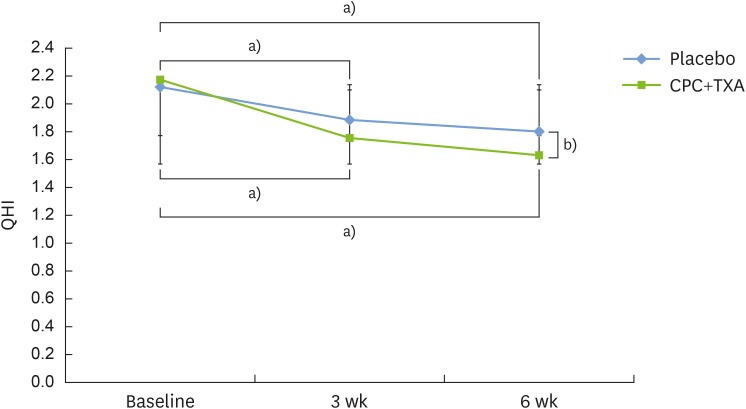J Periodontal Implant Sci.
2017 Jun;47(3):134-142. 10.5051/jpis.2017.47.3.134.
The antiplaque and bleeding control effects of a cetylpyridinium chloride and tranexamic acid mouth rinse in patients with gingivitis
- Affiliations
-
- 1Department of Periodontology, Kyungpook National University School of Dentistry, Daegu, Korea. periokyg@knu.ac.kr
- 2Department of Biochemistry, Kyungpook National University School of Dentistry, Daegu, Korea.
- 3Department of Periodontology, Research Institute for Oral Sciences, Gangneung-Wonju National University College of Dentistry, Gangneung, Korea.
- KMID: 2383827
- DOI: http://doi.org/10.5051/jpis.2017.47.3.134
Abstract
- PURPOSE
This study aimed to evaluate the effects of a cetylpyridinium chloride (CPC) and tranexamic acid (TXA) mouth rinse on patients with gingivitis.
METHODS
This randomized, placebo-controlled, double-blind, parallel-group, clinical trial included 45 healthy adults with gingivitis, who were randomized into 2 groups. The experimental group used a 0.05% CPC and 0.05% TXA mouth rinse, and the control group used a placebo mouth rinse. The following clinical indices were assessed at baseline, at 3 weeks, and at 6 weeks: the Turesky-Quigley-Hein plaque index (QHI), the Löe-Silness gingival index (GI), and bleeding on marginal probing (BOMP). The subjects used the mouth rinse during the experimental period for 20 seconds, 4-5 times daily (10 mL each time).
RESULTS
There were no significant differences in the clinical indices between the groups at baseline. In the experimental group (CPC+TXA), a statistically significant improvement was evident in the QHI, GI, and BOMP at 3 and 6 weeks. These results were similar to those observed in the control group at 3 and 6 weeks, although the change in BOMP was not statistically significant in that group. At 6 weeks, the experimental group had a significantly lower mean score for the QHI than the control group.
CONCLUSIONS
This study demonstrated that a CPC and TXA mouth rinse exhibited significant antiplaque and anti-gingivitis efficacy, and had a positive effect on bleeding control when used daily for 6 weeks.
MeSH Terms
Figure
Reference
-
1. Lindhe J, Hamp S, Löe H. Experimental periodontitis in the beagle dog. J Periodontal Res. 1973; 8:1–10. PMID: 4272068.
Article2. Loe H, Theilade E, Jensen SB. Experimental gingivitis in man. J Periodontol. 1965; 36:177–187. PMID: 14296927.3. Axelsson P, Lindhe J. The effect of a preventive programme on dental plaque, gingivitis and caries in schoolchildren. Results after one and two years. J Clin Periodontol. 1974; 1:126–138. PMID: 4532119.
Article4. Axelsson P, Lindhe J. Efficacy of mouthrinses in inhibiting dental plaque and gingivitis in man. J Clin Periodontol. 1987; 14:205–212. PMID: 3294914.
Article5. Van der Weijden FA, Van der Sluijs E, Ciancio SG, Slot DE. Can chemical mouthwash agents achieve plaque/gingivitis control? Dent Clin North Am. 2015; 59:799–829. PMID: 26427569.
Article6. Serrano J, Escribano M, Roldán S, Martín C, Herrera D. Efficacy of adjunctive anti-plaque chemical agents in managing gingivitis: a systematic review and meta-analysis. J Clin Periodontol. 2015; 42(Suppl 16):S106–S138. PMID: 25495592.
Article7. Löe H, Schiött CR, Karring G, Karring T. Two years oral use of chlorhexidine in man. I. General design and clinical effects. J Periodontal Res. 1976; 11:135–144. PMID: 133217.8. Haps S, Slot DE, Berchier CE, Van der Weijden GA. The effect of cetylpyridinium chloride-containing mouth rinses as adjuncts to toothbrushing on plaque and parameters of gingival inflammation: a systematic review. Int J Dent Hyg. 2008; 6:290–303. PMID: 19138180.
Article9. Gunsolley JC. Clinical efficacy of antimicrobial mouthrinses. J Dent. 2010; 38(Suppl 1):S6–S10. PMID: 20621242.
Article10. Dunn CJ, Goa KL. Tranexamic acid: a review of its use in surgery and other indications. Drugs. 1999; 57:1005–1032. PMID: 10400410.11. Sindet-Pedersen S. Distribution of tranexamic acid to plasma and saliva after oral administration and mouth rinsing: a pharmacokinetic study. J Clin Pharmacol. 1987; 27:1005–1008. PMID: 3437064.
Article12. Borea G, Montebugnoli L, Capuzzi P, Magelli C. Tranexamic acid as a mouthwash in anticoagulant-treated patients undergoing oral surgery. An alternative method to discontinuing anticoagulant therapy. Oral Surg Oral Med Oral Pathol. 1993; 75:29–31. PMID: 8419869.13. Ramström G, Sindet-Pedersen S, Hall G, Blombäck M, Alander U. Prevention of postsurgical bleeding in oral surgery using tranexamic acid without dose modification of oral anticoagulants. J Oral Maxillofac Surg. 1993; 51:1211–1216. PMID: 8229393.
Article14. Sindet-Pedersen S, Ramström G, Bernvil S, Blombäck M. Hemostatic effect of tranexamic acid mouthwash in anticoagulant-treated patients undergoing oral surgery. N Engl J Med. 1989; 320:840–843. PMID: 2648144.
Article15. Fischman SL. Clinical index systems used to assess the efficacy of mouthrinses on plaque and gingivitis. J Clin Periodontol. 1988; 15:506–510. PMID: 3053792.
Article16. Shim JY, Yim SB, Chung JH, Hong KS. Antiplaque and antigingivitis effects of a mouthrinse containing cetylpyridinium chloride, triclosan and dipotassium glycyrrhizinate. J Periodontal Implant Sci. 2012; 42:33–38. PMID: 22586520.
Article17. White DJ. An alcohol-free therapeutic mouthrinse with cetylpyridinium chloride (CPC)--the latest advance in preventive care: Crest Pro-Health Rinse. Am J Dent. 2005; 18:3A–8A. PMID: 15810473.18. Kozak KM, Gibb R, Dunavent J, White DJ. Efficacy of a high bioavailable cetylpyridinium chloride mouthrinse over a 24-hour period: a plaque imaging study. Am J Dent. 2005; 18:18A–23A.19. Gunsolley JC. A meta-analysis of six-month studies of antiplaque and antigingivitis agents. J Am Dent Assoc. 2006; 137:1649–1657. PMID: 17138709.
Article20. Stookey GK, Beiswanger B, Mau M, Isaacs RL, Witt JJ, Gibb R. A 6-month clinical study assessing the safety and efficacy of two cetylpyridinium chloride mouthrinses. Am J Dent. 2005; 18:24A–28A.
- Full Text Links
- Actions
-
Cited
- CITED
-
- Close
- Share
- Similar articles
-
- Antiplaque and antigingivitis effects of a mouthrinse containing cetylpyridinium chloride, triclosan and dipotassium glycyrrhizinate
- Lysozyme hydrochloride 0.01%, sodium fluoride 0.02%, cetylpyridinium chloride 0.05% antibacterial and sterilizing effect of mouth freshener
- A Clinical Study of the Effect of Periodontitis-Medical Gel on Human Gingivitis and Periodontitis
- Effect of Cetylpyridinium Chloride on Gingival Inflammation and Plaque Accumulation
- Efficacy of alcohol-free cetylpyridinium chloride on periodontal disease in beagle dogs via drinking water additive and oral gel





